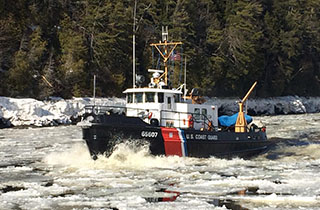Growing ice conditions on the Great Lakes led Coast Guard Sector Sault Ste Marie to start its annual Operation Taconite icebreaking program this week. After a slow start to winter on the East Coast, the Coast Guard began to ramp up for Operation Reliable Energy for Northeast Winters to keep fuel shipments moving between New York and New England.
On the western Great Lakes, the 225’x46’ cutter Adler is performing icebreaking duties for the ports of Duluth, Minn., and Superior, Wisc., while the 140’x37.5’ Bay class cutters Mobile Bay and Katmai Bay are working the St. Marys River. The 240’x58.6’ cutter Mackinaw recently was called to assist two vessels into the Port of Green Bay, Wisc.
Additional icebreakers are expected to join the operation in the coming days, Coast Guard officials said.
 Icebreaking cutter Thunder Bay on the Hudson River in March 2015. USCG photo.Named for the iron ore shipped from Lake Superior ports, Operation Taconite is the Coast Guard’s largest domestic icebreaking operation, encompassing Lake Superior, the St. Marys River, the Straits of Mackinac, Georgian Bay, and all of Lake Michigan. The operation includes closing the Pipe Island and West Neebish Channels in the St Marys River, with an effective closure time of 1 p.m. Saturday, Jan. 16.
Icebreaking cutter Thunder Bay on the Hudson River in March 2015. USCG photo.Named for the iron ore shipped from Lake Superior ports, Operation Taconite is the Coast Guard’s largest domestic icebreaking operation, encompassing Lake Superior, the St. Marys River, the Straits of Mackinac, Georgian Bay, and all of Lake Michigan. The operation includes closing the Pipe Island and West Neebish Channels in the St Marys River, with an effective closure time of 1 p.m. Saturday, Jan. 16.
“In the coming weeks, additional waterways may close after due consideration is given to the protection of the marine environment, the need for cross-channel traffic, and the safety of the island residents; who in the course of their daily business use naturally-formed ice bridges for transportation to and from the mainland,” according to a Coast Guard statement.
Winter 2014-2015 was especially harsh both on the Great Lakes and in the Northeast, where ice conditions were at their worst since 2004, and saltwater ice formed in places where it had not been seen since then. New England is especially reliant on oil for home heating, and 90% of that supply moves by barge. An average 10 million bbl. of fuel in 300 vessels transit the Hudson River every winter, according to the Coast Guard.
In the Northeast, the Coast Guard employs vessels ranging from the 225’x46’ Juniper class and 175’x36’ Keeper class buoy tenders, to small harbor tugs and utility boats.
Last winter, the Hudson began to freeze in mid-December, and some New England rivers had ice into early April. Unseasonably warm weather in late fall and early winter delayed this ice season, but it is coming on now with New England night temperatures in the single digits.




